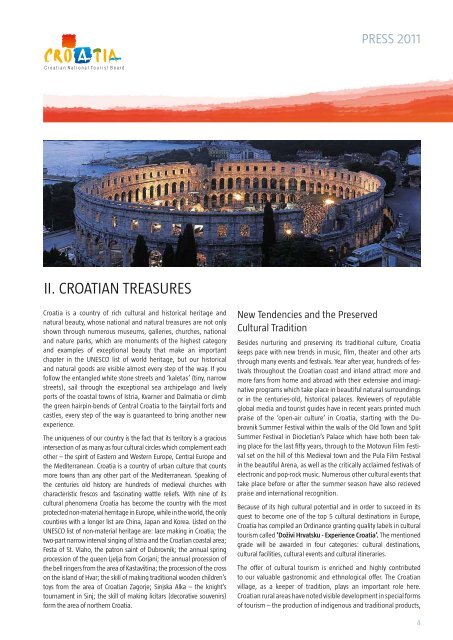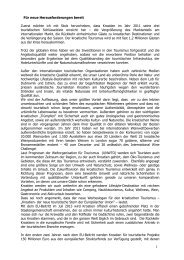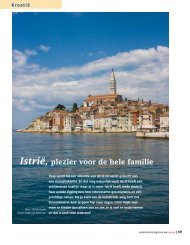You also want an ePaper? Increase the reach of your titles
YUMPU automatically turns print PDFs into web optimized ePapers that Google loves.
PRESS <strong>2011</strong><br />
II. CROATIAN TREASURES<br />
Croatia is a country of rich cultural and historical heritage and<br />
natural beauty, whose national and natural treasures are not only<br />
shown through numerous museums, galleries, churches, national<br />
and nature parks, which are monuments of the highest category<br />
and examples of exceptional beauty that make an important<br />
chapter in the UNESCO list of world heritage, but our historical<br />
and natural goods are visible almost every step of the way. If you<br />
follow the entangled white stone streets and ‘kaletas’ (tiny, narrow<br />
streets), sail through the exceptional sea archipelago and lively<br />
ports of the coastal towns of Istria, Kvarner and Dalmatia or climb<br />
the green hairpin-bends of Central Croatia to the fairytail forts and<br />
castles, every step of the way is guaranteed to bring another new<br />
experience.<br />
The uniqueness of our country is the fact that its teritory is a gracious<br />
intersection of as many as four cultural circles which complement each<br />
other – the spirit of Eastern and Western Europe, Central Europe and<br />
the Mediterranean. Croatia is a country of urban culture that counts<br />
more towns than any other part of the Mediterranean. Speaking of<br />
the centuries old history are hundreds of medieval churches with<br />
characteristic frescos and fascinating wattle reliefs. With nine of its<br />
cultural phenomena Croatia has become the country with the most<br />
protected non-material herritage in Europe, while in the world, the only<br />
countires with a longer list are China, Japan and Korea. Listed on the<br />
UNESCO list of non-material heritage are: lace making in Croatia; the<br />
two-part narrow interval singing of Istria and the Croatian coastal area;<br />
Festa of St. Vlaho, the patron saint of Dubrovnik; the annual spring<br />
procession of the queen Ljelja from Gorjani; the annual procession of<br />
the bell ringers from the area of Kastavština; the procession of the cross<br />
on the island of Hvar; the skill of making traditional wooden children’s<br />
toys from the area of Croatian Zagorje; Sinjska Alka – the knight’s<br />
tournament in Sinj; the skill of making licitars (decorative souvenirs)<br />
form the area of northern Croatia.<br />
New Tendencies and the Preserved<br />
Cultural Tradition<br />
Besides nurturing and preserving its traditional culture, Croatia<br />
keeps pace with new trends in music, film, theater and other arts<br />
through many events and festivals. Year after year, hundreds of festivals<br />
throughout the Croatian coast and inland attract more and<br />
more fans from home and abroad with their extensive and imaginative<br />
programs which take place in beautiful natural surroundings<br />
or in the centuries-old, historical palaces. Reviewers of reputable<br />
global media and tourist guides have in recent years printed much<br />
praise of the ‘open-air culture’ in Croatia, starting with the Dubrovnik<br />
Summer Festival within the walls of the Old Town and Split<br />
Summer Festival in Diocletian’s Palace which have both been taking<br />
place for the last fifty years, through to the Motovun Film Festival<br />
set on the hill of this Medieval town and the Pula Film Festival<br />
in the beautiful Arena, as well as the critically acclaimed festivals of<br />
electronic and pop-rock music. Numerous other cultural events that<br />
take place before or after the summer season have also recieved<br />
praise and international recognition.<br />
Because of its high cultural potential and in order to succeed in its<br />
quest to become one of the top 5 cultural destinations in Europe,<br />
Croatia has compiled an Ordinance granting quality labels in cultural<br />
tourism called ‘Doživi Hrvatsku - Experience Croatia’. The mentioned<br />
grade will be awarded in four categories: cultural destinations,<br />
cultural facilities, cultural events and cultural itineraries.<br />
The offer of cultural tourism is enriched and highly contributed<br />
to our valuable gastronomic and ethnological offer. The Croatian<br />
village, as a keeper of tradition, plays an important role here.<br />
Croatian rural areas have noted visible development in special forms<br />
of tourism – the production of indigenous and traditional products,<br />
4
















